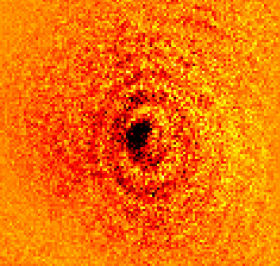4 July 2012
Atom shadow photographed using traditional microscopy
by Will Parker
 For the first time, Griffith University (Australia) scientists have managed to photograph the shadow of an atom using only visible light and an extremely powerful optical microscope. Traditionally, images at such magnifications were the preserve of electron microscopes and other exotic imaging systems.
For the first time, Griffith University (Australia) scientists have managed to photograph the shadow of an atom using only visible light and an extremely powerful optical microscope. Traditionally, images at such magnifications were the preserve of electron microscopes and other exotic imaging systems.
"We wanted to investigate how few atoms are required to cast a shadow and we proved it takes just one. We have reached the extreme limit of microscopy; you can not see anything smaller than an atom using visible light," said Professor Dave Kielpinski of Griffith University's Centre for Quantum Dynamics.
Writing about the work in Nature Communications, Kielpinski explained how he and his team electrostatically trapped single ions of the element ytterbium and exposed them to a specific frequency of light. Under this light the atom's shadow was cast onto a detector, and a digital camera was then able to capture the image.
"By using the ultra hi-res microscope we were able to concentrate the image down to a smaller area than has been achieved before, creating a darker image which is easier to see," Kielpinski said.
Research team member, Dr Erik Streed, said the achievement could produce follow-on benefits for biomicroscopy. "Because we are able to predict how dark a single atom should be, as in how much light it should absorb in forming a shadow, we can measure if the microscope is achieving the maximum contrast allowed by physics. This is important if you want to look at very small and fragile biological samples such as DNA strands where exposure to too much UV light or x-rays will harm the material. We can now predict how much light is needed to observe processes within cells, under optimum microscopy conditions, without crossing the threshold and destroying them."
Related:
Discuss this article in our forum
Single Pixel Camera Snaps High-Res Images
Atomic spin captured in image
Pimp My Electron Microscope
Microscope Resolution Barrier Broken
Source: Griffith University
